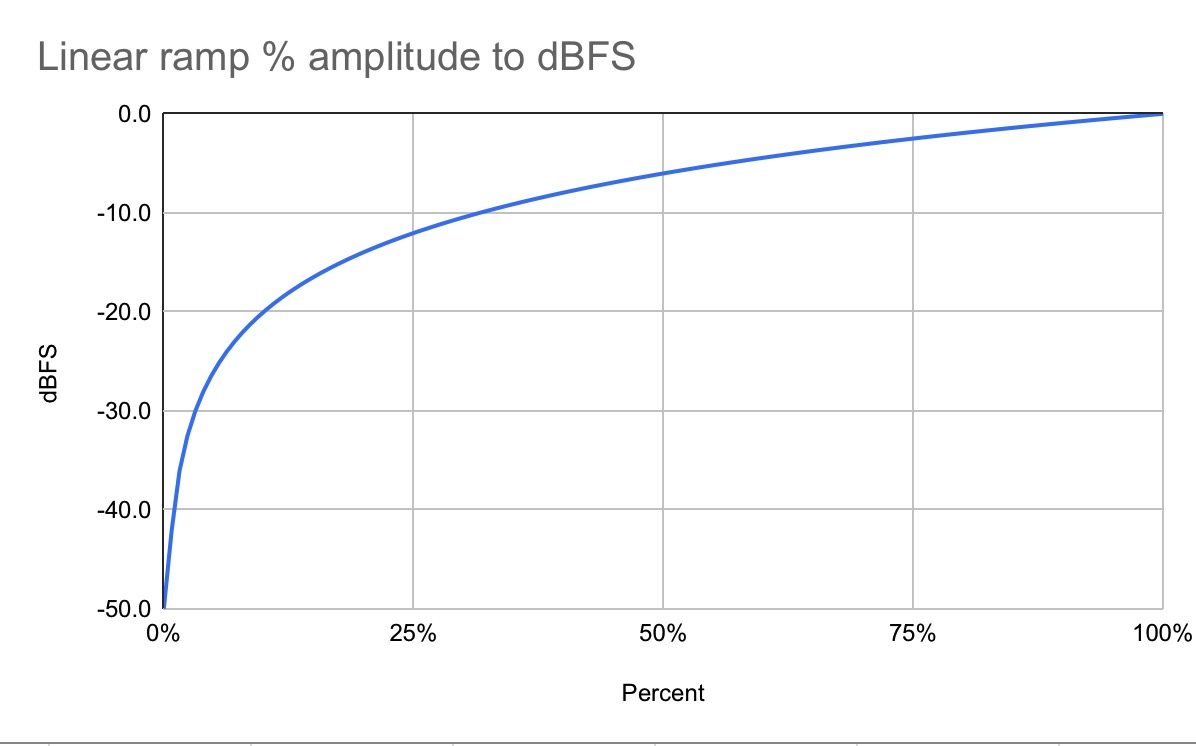Regarding the response curve of cc7 and cc11 sliders, I believe they might be responding a little differently than most people are used to with typical daw audio faders and automation lanes, mainly due to the way automation lanes are using DB as their vertical Y axes. Its not entirely clear what kind of actual attenuation calculation is being used by Synchron for CC values 1-127. I still think it's most likely a simple amplitude percentage that Synchron itself is applying, but Vsl will have to clarify in order to know for sure.
Typical daw mixer fader automation lanes use dBFS as their Y axis, which is not a linear scale; but anyway if you draw a linear ramp on a non-linear db based automation lane then the resulting amplitude curve will actually be logarithmic in nature by virtue of the fact that the Y axis of that automation lane is not linear., even though the line on the lane is a straight linear line It is being expressed in DB's, which is a non-linear scale, imposed by the DAW...
Midi cc automation lanes are not based on db for the y axis so the DAW itself is not adding any curve by virtue of that. It will depend on what synchron does internally for its attenuation calculation when given a linear midi cc ramp; as to how a linear ramp drawn in a midi cc lane is translated to actual gain reduction, ie, the response curve. Macker has hinted to this in another thread.
My own testing with external meter has shown very similar results that Macker showed on another thread.
There is a standard calculation for converting amplitude to a dBFS value, which is:
@Another User said:
dBFS = 20 * log10 (amplitude percent)
This calculation will take a totally linear amplitude percentage ramp line...and compute to a curved dBFS line, in terms of how DB's are expressed, which is a logarithmic scale itself. This calculated curve is very similar to the results Macker posted on one of the other threads, and matches my own measurements also (using external meter), however, the curve is not quite exactly the same. Its curved the same direction, but it's hard to compare the results between theoretical calculations mentioned above, and the actual measured results...since reference level is an important part of DB calculations.
The theoretical curve, based on a linear ramp of amplitude percentage, calculated as a dBFS measurement with 0db as the reference level; looks like the attached jpg. that similar curve is how I have found cc7/cc11 faders to respond when measuring the results with external meter...and also mixer volume faders have a similar curve..but the exact humpiness (for lack of a better word) of the curve is different in real world vs theoretical, most likely due to the real world measurement being based on a non-zero reference level.
I have found that the bottom 1/3 of the CC sliders range are basically useless because they attenuate the signal so much and so quickly, at already very reduced levels so as to be mostly meaningless. So the true useful range of these sliders is really between roughly 50-127.
I personally think most people are not really paying attention to the DB readings while riding their CC11 control for expression, they are using their ears and affecting expression. So I'm not sure how "dire" need there really is to know what the actual DB response curve is. I think most likely it is a simple percentage being applied to the midi CC scale, which is linear in nature..and that displays itself in dBFS measurements as a logarithmic curve. Due to the humpiness of this curve, the bottom-50 midi increments are probably not useful most of the time.
Regarding VelXF, just playing it a few minutes shows that it is using more intelligence then the CC7/CC11 response curves, to mimic a typical response that is more fitting for each instrument, with the full range of 128 midi cc values effecting the dynamic range in a much more realistic window that each particular instrument is capable of. In my mind, this is the most intuitive control to use for dynamic expression of Synchron instruments. it has the greatest usable CC range, not to mention it affects the timbre in realistic ways.
I feel CC7 should at most be used for setting orchestra level, set it and forget it. CC11 can be used for fine adjustments after having used VelXF first. Even better in my mind is to leave CC11 alone and use mixer automation for these kinds of fine adjustments, which has more resolution anyway.

